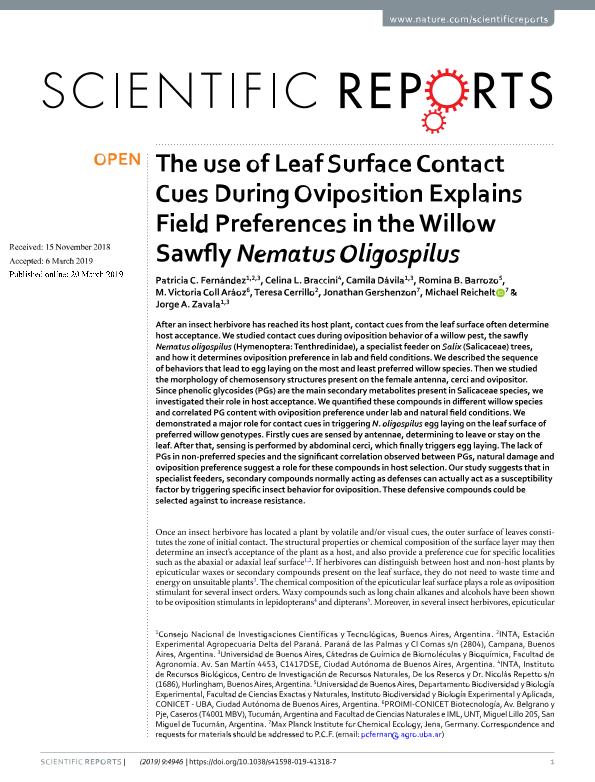Mostrar el registro sencillo del ítem
dc.contributor.author
Fernandez, Patricia Carina

dc.contributor.author
Braccini, Celina Laura

dc.contributor.author
Dávila, Camila

dc.contributor.author
Barrozo, Romina

dc.contributor.author
Coll Araoz, Maria Victoria

dc.contributor.author
Cerrillo, Teresa

dc.contributor.author
Gershenzon, Jonathan

dc.contributor.author
Reichelt, Michael
dc.contributor.author
Zavala, Jorge Alberto

dc.date.available
2021-02-01T12:10:35Z
dc.date.issued
2019-03
dc.identifier.citation
Fernandez, Patricia Carina; Braccini, Celina Laura; Dávila, Camila; Barrozo, Romina; Coll Araoz, Maria Victoria; et al.; The use of Leaf Surface Contact Cues During Oviposition Explains Field Preferences in the Willow Sawfly Nematus Oligospilus; Nature Publishing Group; Scientific Reports; 9; 1; 3-2019; 1-13
dc.identifier.issn
2045-2322
dc.identifier.uri
http://hdl.handle.net/11336/124310
dc.description.abstract
After an insect herbivore has reached its host plant, contact cues from the leaf surface often determine host acceptance. We studied contact cues during oviposition behavior of a willow pest, the sawfly Nematus oligospilus (Hymenoptera: Tenthredinidae), a specialist feeder on Salix (Salicaceae) trees, and how it determines oviposition preference in lab and field conditions. We described the sequence of behaviors that lead to egg laying on the most and least preferred willow species. Then we studied the morphology of chemosensory structures present on the female antenna, cerci and ovipositor. Since phenolic glycosides (PGs) are the main secondary metabolites present in Salicaceae species, we investigated their role in host acceptance. We quantified these compounds in different willow species and correlated PG content with oviposition preference under lab and natural field conditions. We demonstrated a major role for contact cues in triggering N. oligospilus egg laying on the leaf surface of preferred willow genotypes. Firstly cues are sensed by antennae, determining to leave or stay on the leaf. After that, sensing is performed by abdominal cerci, which finally triggers egg laying. The lack of PGs in non-preferred species and the significant correlation observed between PGs, natural damage and oviposition preference suggest a role for these compounds in host selection. Our study suggests that in specialist feeders, secondary compounds normally acting as defenses can actually act as a susceptibility factor by triggering specific insect behavior for oviposition. These defensive compounds could be selected against to increase resistance.
dc.format
application/pdf
dc.language.iso
eng
dc.publisher
Nature Publishing Group

dc.rights
info:eu-repo/semantics/openAccess
dc.rights.uri
https://creativecommons.org/licenses/by/2.5/ar/
dc.subject
PHENOLIC GLYCOSIDES
dc.subject
GENETIC IMPROVEMENT
dc.subject
SUSCEPTIBILITY
dc.subject.classification
Ecología

dc.subject.classification
Ciencias Biológicas

dc.subject.classification
CIENCIAS NATURALES Y EXACTAS

dc.title
The use of Leaf Surface Contact Cues During Oviposition Explains Field Preferences in the Willow Sawfly Nematus Oligospilus
dc.type
info:eu-repo/semantics/article
dc.type
info:ar-repo/semantics/artículo
dc.type
info:eu-repo/semantics/publishedVersion
dc.date.updated
2020-11-13T20:47:56Z
dc.journal.volume
9
dc.journal.number
1
dc.journal.pagination
1-13
dc.journal.pais
Reino Unido

dc.description.fil
Fil: Fernandez, Patricia Carina. Consejo Nacional de Investigaciones Científicas y Técnicas; Argentina. Instituto Nacional de Tecnología Agropecuaria. Centro Regional Buenos Aires Norte. Estación Experimental Agropecuaria Delta del Paraná; Argentina. Universidad de Buenos Aires. Facultad de Agronomía; Argentina
dc.description.fil
Fil: Braccini, Celina Laura. Instituto Nacional de Tecnología Agropecuaria. Centro de Investigación de Recursos Naturales. Instituto de Recursos Biológicos; Argentina
dc.description.fil
Fil: Dávila, Camila. Consejo Nacional de Investigaciones Científicas y Técnicas. Oficina de Coordinación Administrativa Parque Centenario. Instituto de Investigaciones en Biociencias Agrícolas y Ambientales. Universidad de Buenos Aires. Facultad de Agronomía. Instituto de Investigaciones en Biociencias Agrícolas y Ambientales; Argentina
dc.description.fil
Fil: Barrozo, Romina. Consejo Nacional de Investigaciones Científicas y Técnicas. Oficina de Coordinación Administrativa Ciudad Universitaria. Instituto de Biodiversidad y Biología Experimental y Aplicada. Universidad de Buenos Aires. Facultad de Ciencias Exactas y Naturales. Instituto de Biodiversidad y Biología Experimental y Aplicada; Argentina
dc.description.fil
Fil: Coll Araoz, Maria Victoria. Consejo Nacional de Investigaciones Científicas y Técnicas. Centro Científico Tecnológico Conicet - Tucumán. Planta Piloto de Procesos Industriales Microbiológicos; Argentina
dc.description.fil
Fil: Cerrillo, Teresa. Instituto Nacional de Tecnología Agropecuaria. Centro Regional Buenos Aires Norte. Estación Experimental Agropecuaria Delta del Paraná; Argentina
dc.description.fil
Fil: Gershenzon, Jonathan. Max Planck Institute for Chemical Ecology; Alemania
dc.description.fil
Fil: Reichelt, Michael. Max Planck Institute for Chemical Ecology; Alemania
dc.description.fil
Fil: Zavala, Jorge Alberto. Consejo Nacional de Investigaciones Científicas y Técnicas. Oficina de Coordinación Administrativa Parque Centenario. Instituto de Investigaciones en Biociencias Agrícolas y Ambientales. Universidad de Buenos Aires. Facultad de Agronomía. Instituto de Investigaciones en Biociencias Agrícolas y Ambientales; Argentina
dc.journal.title
Scientific Reports
dc.relation.alternativeid
info:eu-repo/semantics/altIdentifier/url/https://www.nature.com/articles/s41598-019-41318-7
dc.relation.alternativeid
info:eu-repo/semantics/altIdentifier/doi/http://dx.doi.org/10.1038/s41598-019-41318-7
Archivos asociados
